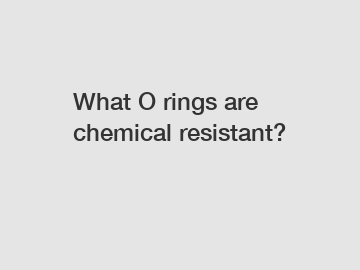Jan. 15, 2024
Rubber & Plastics
What O rings are chemical resistant?
O rings are an essential component in many industries, providing a reliable seal to prevent leakage and contamination. When it comes to selecting the right O rings for your application, it is crucial to consider their resistance to chemicals. Chemical resistance is particularly important in industries such as pharmaceuticals, oil and gas, and manufacturing, where exposure to various chemicals is a regular occurrence. In this article, we will explore the types of O rings that are chemical resistant and why it matters.
Chemical resistance is the ability of a material to withstand exposure to a particular chemical without undergoing significant degradation or damage. O rings are typically made from various elastomer materials, such as nitrile rubber, fluorocarbon (Viton), silicone, and EPDM. Each material offers different levels of chemical resistance, making them suitable for specific applications. Depending on the nature of the chemicals involved, it is important to choose an O ring that can withstand the harsh chemicals it will be exposed to. .

So, what O ring materials are chemical resistant? Let's delve into some of the key types:
1. Nitrile Rubber O rings:
Nitrile rubber, also known as Buna-N, is a popular choice for O rings due to its excellent resistance to oils, fuels, and many solvents. This material offers good resistance to hydrocarbons and is commonly used in applications where exposure to petroleum-based products is frequent. However, nitrile rubber may not be the best choice for applications involving ketones, ozone, or strong acids.
2. Fluorocarbon (Viton) O rings:
Fluorocarbon O rings, often known by the brand name Viton, are highly resistant to a wide range of chemicals, including acids, fuels, oils, and solvents. These O rings exhibit superior performance in high-temperature applications and offer excellent resistance to oxidation and aging. Their resilience in harsh environments makes them ideal for applications in the automotive, aerospace, and chemical industries.
3. Silicone O rings:
Silicone O rings are known for their flexibility and high-temperature resistance. They exhibit good resistance to water, alcohols, and some diluted acids and bases. However, silicone is not recommended for use with oils, fuels, solvents, and concentrated acids. Silicone O rings find application in various industries, including food and beverage, medical, and electronics, where they provide excellent sealing properties.
4. EPDM O rings:
EPDM (Ethylene Propylene Diene Monomer) O rings are well-suited for applications involving exposure to hot water, steam, and mild acids and bases. They exhibit good resistance to ozone, weathering, and aging. EPDM O rings are commonly used in plumbing systems, HVAC units, and automotive applications, where they deliver reliable sealing performance.
Considering the importance of chemical resistance in specific applications, here are a few key points to keep in mind:
- Understand the chemicals involved: Before selecting an O ring material, it is crucial to thoroughly understand the types of chemicals the O ring will be exposed to. Different chemicals can have varying effects on O ring materials, so choose a material that is compatible with the specific chemicals in your application.
- Consult with experts: If you are unsure about the compatibility of an O ring material with certain chemicals, it is always best to consult with material experts or O ring manufacturers. They can guide you in selecting the most appropriate material for your specific needs.
- Consider temperature limitations: Chemical resistance can be impacted by temperature extremes, so it is important to consider the operating temperature range of the application. Some materials may exhibit excellent chemical resistance at room temperature but lose their resistance at higher temperatures.
- Regular inspection and replacement: Even chemical-resistant O rings can degrade over time due to exposure to harsh chemicals. Regular inspection and replacement of O rings are essential to maintain optimal sealing performance and prevent potential leaks or contamination.
In conclusion, selecting the right O ring material with chemical resistance properties is crucial in industries where exposure to chemicals is inevitable. Nitrile rubber, fluorocarbon (Viton), silicone, and EPDM O rings are among the most common materials used, each offering different levels of resistance to various chemicals. By considering the specific chemicals involved, consulting experts, and considering temperature limitations, you can ensure the longevity and effectiveness of your O ring seals in chemical-rich environments.
The company is the world’s best Hoof Top Cow Rubber Mat, Diamond with hammer top cow rubber mat, Diamond Hammer Top Cow Rubber Mat supplier. We are your one-stop shop for all needs. Our staff are highly-specialized and will help you find the product you need.
If you are interested in sending in a Guest Blogger Submission,welcome to write for us!
All Comments ( 0 )